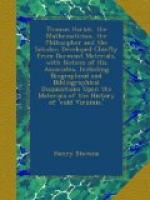It was necessary however in the interests of England for Hakluyt in this Discourse to revive and substantiate the English rights in America by putting forward the prior discovery by the Cabots in 1497-1498. Though he presents this direct claim modestly, yet like Sir Humphrey Gilbert he founds it upon insufficient evidence. In a loose manner he speaks of Cabot and not the Cabots, and attributes to Sebastian the son what properly belongs to John the father. He reposes full confidence in the loose and gossiping statements of Peter Martyr that Sebastian Cabot, a quarter of a century after the discovery, told him that at the time, 1497 or 98,he had explored the coast to the latitude of Gibraltar, that is to Chesapeake Bay and the longitude of Cuba or the city of Cincinnati, a thing not probable, in as much as the active old pilot mayor was never able to declare, down to the time of Gomez, that he had been on that coast before. It would have been foolish in him to fit out in 1524 Gomez to ’ discover ’ what the pilot mayor had already explored in 1497.
Hakluyt’s arguments and historical statements in this Discourse of 1584 to the present time have always been presented by English diplomatists with confidence, especially against the French. Yet the French continued to maintain their occupation of Cape Breton, the Gulf of St Lawrence and Canada, which together they called New France. It is now however made apparent from contemporary historical documents that have recently been brought to light from the archives of Spain and Venice that John Cabot, accompanied by his son Sebastian, then a youth of some nineteen or twenty years, in 1497 took possession of Cape Breton in the names of Venice and England conjointly, and raised the flags of St Mark and St George. There is not yet any trustworthy evidence that they went south of Cape Breton either in that or the voyage of 1498.
Hakluyt in his Divers Voyages in 1582 did not venture to make this Cabot claim so strong as in this Discourse. In his dedication to Sir Philip Sidney he quaintly says that he ’ put downe the title which we haue to this part of America which is from Florida to 67 degrees northwarde by the letters patentes graunted to John Cabote and his three sonnes,’ simply meaning that he had printed the first patent of 5th May 1496. In his title page he speaks of the Discoverie of America,’ made first of all by our Englishmen and afterwards by the Frenchmen and Bretons.’ He does not question the rights and privileges of Frenchmen to the Gulf of St Lawrence and Canada, because they were in the occupation of a Christian prince.
This Discourse of Western Planting therefore, and the voyage of Amadas and Barlow, in 1584, at the instigation and expense of Raleigh, based on a thorough knowledge of the Huguenot and Spanish expeditions to Florida in 1562-1568, are all parts of Virginia history, and therefore are preliminary to Hariot’s Report. It should be borne in mind that these terms Florida and Virginia as used by the Spaniards, French, and English, included the whole country from the point of Florida through the Carolinas and Virginia to the Chesapeake Bay, or perhaps even to Bacalaos.




